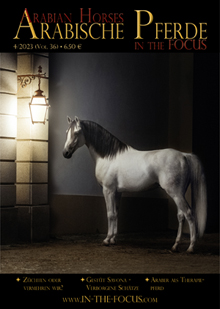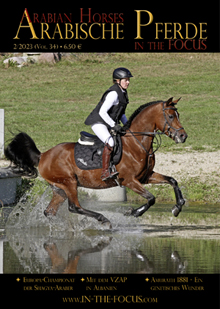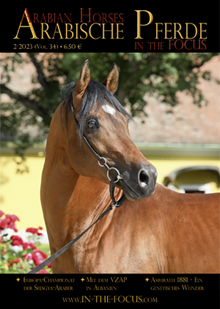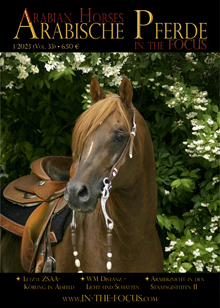The Arabian horse does no more or less than other breeds suffer from genetic defects, but each breed has some specific hereditary diseases, which breeders should know in order to make a responsible breeding plan. In the following article Alban Krösbacher explains the major hereditary diseases in Arabian horses, and those which are predominantely found in the Arabian breed.

Severe Combined Immunodeficiency
Over many decades, Severe Combined Immunodeficiency (SCID) was a major problem for Arabian horse breeders around the globe, and was subject of controversial discussions. The disease was first mentioned in 1973 in Australia, where two purebred Arabian foals were born that had the same sire and dam. Even back then it was ascertained, that both foals suffered from a defect in the immune system, concerning the B and T lymphocytes. An important advance in the study of SCID was made, when it could be considered proven that this is an autosomal recessive disease.
This finding was of great importance in the way of how to deal with this fatal genetic defect, because from now on, it was known that a sick foal can only be born, if both parents are carriers of this disease. However, at this time there was still no test by which carriers could be identified. The solution to this problem was found, when in 1997 a genetic test was developed. The evaluation of the results of this first genetic testing confirmed that with it a correct identification of carriers of the disease as well as of affected foals is possible. The mutation, of which we talk in this context, concerns the enzyme DNAPKcs, a component of the immune system, that is responsible for building a number of molecules of the immune system. A reduced activity of this enzyme is responsible for the fact, that affected foals are born without mature and functional B and T lymphocytes, which makes them especially vulnerable to a variety of infectious diseases. Affected foals show mostly bacterial, viral or fungal infections of the respiratory tract. In addition, the digestive tract is frequently affected. Depending on the passive immune transfer through the colostrum and the risk of infection by pathogens to which the foal is exposed, the appearance of the first clinical symptoms vary between the first and third month of life. Although the treatment of SCID foals has already been successfully carried out by means of a stem cell transplant, this type of treatment is probably not relevant in practice. Although a medical treatment can lead to a temporary success, the infection usually returns within a short time, and the foals usually die before the fifth month of life (or be euthanized).
With regard to the occurrence frequency of SCID there are different opinions, because they are based on various studies carried out in different countries. So the results are far apart, depending on the study, and vary between 1.5% up to 25.7% carriers. This difference is probably caused by the fact that different populations were tested in these studies, and in studies with a participation of predominantly “affected” populations, the rate is strongly driven upwards. Also, the studies involved usually only a few hundred animals. However, detailed data is provided by the company VetGen Inc., which was instrumental in the development of the SCID test and offers them as well. Therefore they have a lot of data available, the basis on which more meaningful analysis could be carried out. Analysis of the results from the examination of 7,700 horses during 1997 to May 2007 resulted in 17% carriers of the mutation, and 0.3% affected (ie diseased) foals for SCID. However, it needs to be considered that the actual number of affected foals is likely higher, as samples for examination are not submitted from each affected foal, and these are therefore not included in the statistics of VetGen Inc.
Coat Colour Dilution Lethal
Another disease, for which a hereditary nature similar to the autosomal recessive inheritance is suspected, is the Coat Colour Dilution Lethal CCDL (also known as Lavender Foal Syndrome, LFS). While SCID does not only occur in purebred Arabians, but also in a variety of other species such as mice, dogs and not least humans, CCDL is restricted to purebred Arabian foals with Egyptian pedigree or of predominantly Egyptian breeding.
Because of the few data available, it is still not possible to describe the pathology of this disease exactly. A biochemical disorder of the central nervous system has been suggested as a cause of the symptoms. The underlying cause of the symptoms is a genetic defect, more precisely, a mutation in the gene MYO5A that causes neurological dysfunction in the newborn foal. The affected foals have a characteristic dilution of their basic coat colour. The neurological disorders include convulsive seizures (tetany), severe overstretching of limbs, neck and back (opisthotonus), nystagmus, the foals remain lying on their side, are unable to stand and drink, but the sucking reflex is present. The foals can not survive; they die shortly after birth (48-72 hours) or have to be euthanized. Haematology and serum biochemistry are normal.
Post mortem examinations showed signs of wear on protruding areas of the skull. Damage (lesions) of the central nervous system could not be found. The most obvious common feature of all foals is a dull, faded coat colour, from which this disease takes its name.
About the frequency of the genetic defect, there are few studies, the carrier frequency in the US is said to be 10.3%, in South Africa, it was 11.7% in 2009.
It should be emphasized that – regardless of the manner of inheritance – it is primarily important not to use carrier animals in breeding. In the differential diagnosis a delimitation of CCDL against the following diseases are recommended: Neonatal septicaemia, neonatal encephalopathy, idiopathic or Benign Epilepsy and occipitoatlantoaxiale malformation. Two of these diseases will be discussed in more detail, since they have some relevance in purebred Arabians in particular. CCDL should be included in the differential diagnosis of any Arabian foal with Egyptian ancestry, who shows an unusual coat colour and paroxysmal malfunctions immediately after birth.
Idiopathic Epilepsy (IE)
Compared to other species, seizures occur in horses very rarely, and there are few documented cases of epilepsy. Nevertheless, they have been repeatedly observed, particularly in purebred Arabians within certain lines. Because of the lack of information about such a disease, a retrospective study was carried out in 2006, including 22 Arabian foals with diagnosed epilepsy, which were presented and treated in the years 1985-2005 in the Veterinary Medical Teaching Hospital of the University of California, Davis. In this study, an idiopathic (benign) epilepsy was diagnosed using the exclusion method. This diagnosis was confirmed by the description of the affected foals, their history, the precise investigation and lab results and imaging findings. All foals showed during a period of 1 to 60 days before admission to the veterinary clinic, multiple general or partial seizures; most of the foals were presented within one day after onset of clinical symptoms. The average age at the time of the first attacks was two months. The foals showed reduced to non-existent response to danger, were blind and showed abnormal mental activity (disorientation, lethargy, clouding of consciousness). Only few noticeable signs of an attack could be observed. The majority of attacks lasted less than a minute and occurred spontaneously. After the attack all foals suffered from blindness, the loss of consciousness, lethargy and disorientation followed. In some foals, also increased excitability, ataxia, deficits in proprioception, dilated pupils, and salivation were observed. With the exception of blindness, which could last up to three weeks, the neurological status of the foal between attacks was unremarkable. The most commonly disease occurring at the same time was pneumonia. Most of the foals responded to treatment with antiepileptics, the authors of the study emphasize that the medication dosage should be adjusted individually. Information obtained from the owners and veterinarians, which further treated the foals after discharge, showed that all 21 foals (one foal died as a result of a seizure in the hospital) recovered well without any particular incidents within a period of two-and-a-half to nine months. When the drug treatment with antiepileptics was ended, no foal responded with further attacks. All foals were of Egyptian parentage. In the scientific literature there is only one other report, which describes a form of epilepsy in purebred Arabians with Egyptian pedigree. The results were the same except for a few minor differences.
Because of the study, for any purebred Arabian foal, showing signs of trauma or injury, and suddenly suffer from blindness and disorientation, the conclusion about an epilepsy can be drawn.
There is then a strong suspicion of IE, and differentiated diagnoses need to be initiated. In addition, for any affected foal potential additional diseases and secondary injuries should be respected. However, one should never conclude IE solely based on the breed and parentage of the patient.
The disease heals by it-self and disappears at the age of one to two years. The prognosis is therefore very good and there are no complications.
Idiopathic epilepsy has been described only in the Arabian horse; especially in purebred Arabians of Egyptian origin (Egyptian Arabians). Information about the carrier frequency does not exist; there also is no DNA test at present.
Occipito-atlanto-axial Malformation
OAAM is defined as a fusion of the vertebrae in the region of the atlas and axis and the base of the skull, which leads to compression and spinal cord injury. The first study on this phenomenon dates back to 1978 and was carried out on nine horses with congenital malformations of the first two cervical vertebrae and the occiput (back of the head). In addition, the results of two case reports were included in the study. Based on the findings of clinical studies of the affected animals, which were backed by X-ray and partly carried out as post mortem examinations, three diseases could be defined:
A. Congenital asymmetrical occipito-atlanto-axial malformation;
B. The assymmetric atlanto-occipital fusion; and
C. The occipito-atlanto.axiale malformation (OAAM)
the latter is a bony connection between atlas and axis and the base of the skull, which was found in this study exclusively with Arabs. The clinical symptoms of those foals affected by OAAM ranged from death after birth, to weakness of the limbs, to paralysis of the limbs. Further, a malfunction of muscle coordination could be observed in some foals. In these cases, the clinical symptoms were caused by a progressive compressive pathology of the spinal cord. Since this disease has been found only in horses of the Arabian breed, the authors of this study also highlighted a family-bound nature of OAAM.
It should be noted, that it is necessary to exclude trauma, sepsis, an equine protozoal myelitis, an equine degenerative myelopathy, cervical vertebral malformation (Wobbler syndrome) in the differential diagnosis of a OAAM.
Unfortunately, there is currently no valid test method that can identify OAAM, and although there is some evidence found in the literature that this is an autosomal recessive genetic disease, also this relationship so far is not clearly confirmed by science, presumably because OAAM a very rarely occurring disease. Other studies are based on a multifactorial disease. There remain many questions unresolved with respect to this malformation.
Cerebellar Abiotrophy (CA)
Until a few years ago, CA was little-known among purebred Arabian horse breeders, although this disease occurs almost exclusively in this breed. The cause for this may be due to breeders who are naturally reluctant to disclose that their foal has suffered from a neurological disorder. CA is a degenerative condition of the brain, leading to the occurrence of head tremor and ataxia, the first clinical symptoms are noticeable within a period from birth until the age of six months. Horses suffering from CA are due to their incoordination probably never be used as safe riding horses and often hurt themselves, so they are euthanized sooner or later.
One of the first scientific work that has dealt with the investigation of this disease, dates from the year 1987. Only in the years 2005-2006, the University of California, Davis, launched a project with regards to the treatment and hereditary nature of the disease, which brought substantial advance. Based on data, which indicate the existence of a gene to be responsible for CA, as well as the findings in mice in which the mutation of this gene was detected as the cause of tremors, muscle weakness and a lack of balance, they were searching for this gene also in horses. Here, the aim was that affected animals in future are detected earlier and also carriers of this disease can be identified, whereby the occurrence of the CA can be avoided by appropriate breeding management.
The trigger for the disease seems to be a mutation in which one nucleobase in the DNA (guanine, G) has been replaced by another (adenine, A). This modified genetic code is responsible for the production of another amino acid: the normally produced amino acid arginine is replaced by histidine.
The pathological cause of CA is a premature degeneration of Purkinje cells in the brain. The mechanisms are not yet fully explored. But there are indications that the so-called MUTYH gene in CA-foals is not working properly. This MUTYH gene is involved in the repair of the Purkinje cells. The different severity of clinical symptoms of CA (affected) horses could be due to a different type of MUTYH gene func-
tion, which in turn leads to different damage to Purkinje cells.
While by 2010 only a test based on markers was available (which offered a security of 97%), there is now a new test, which tests for the mutation. The carrier frequency was specified in 2010 with 19.25% (USA), the number of diseased animals with 1.07%.
Guttural Pouch Tympany (GPT)
Finalising the chapter on the various diseases of particular relevance in Arabian horse breeding, Guttural Puch Tympany (GPT) should be briefly described as well. Although it occurs not only within the breed of purebred Arabians, an increased incidence of this disease in this breed, compared to other breeds of horses, can be observed. The GPT is an excessive air influx to one or both guttural pouches that may occur in foals. In literature, different opinions about the origin of this disease are represented. It is believed that an impaired airflow from the guttural pouch leads to the development of a GPT. However, accurate information on the pathogenesis are not available. A typical symptom is the increase in volume of one or both guttural pouches, which causes a displacement of surrounding structures, and often brings snoring breath sounds with it. Basically fillies seem to be affected more often than colts.
The treatment is surgical, and the prognosis for full recovery and for attaining full performance capabilities are very high after successful surgery. The involvement of a genetic component in the development of GPT in purebred Arabians was detected. Furthermore, there is reason to believe that a number of genes are responsible for the occurrence of this disease. Although the exact inheritance of GPT could not be fully clarified, it is possible to give statements about the possible occurrence of this disease with the use of certain parents. In addition to the data available, a rough estimate with respect to the incidence of new cases with GPT based on purebred Arabian foals in Germany can be given, which stood at 0.325%. A connection between inbreeding coefficients, or gender, and the probability of occurrence of a GPT could not be detected.
The Equine Clinic of the University of Veterinary Medicine Hannover has developed a minimally invasive surgical technique in which no anaesthesia is required and which gives according to previous findings very good results.
Alban Krösbacher
The following laboratories offer the respective gene tests:
BIOFOCUS, Germany(SCID, CA, LFS) – www.biofocus.de
GenControl, Germany(SCID, CA, LFS) – www.genecontrol.de
LABOKLIN Basel, Switzerland (SCID; CA; LFS) – www.laboklin.ch
VHL, Van Haeringen Group, Netherlands, Belgium (SCID; CA; LFS) – www.vhlgenetics.com
LABEO Laboratoire Frank Duncombe, France(SCID; CA; LFS) – www.labo-frank-duncombe.fr
Animal Genetics UK, Great Britain(SCID, CA, LFS) – www.animalgenetics.eu
UC Davis, USA (CA, LFS) – www.vgl.ucdavis.edu
VetGen, USA (SCID; CA; LFS) – www.vetgen.com
further online reading:
SCID – www.arabianhorses.org/education/genetic/docs/12Genetic_SCID_2012.pdf
LFS – www.arabianhorses.org/education/genetic/docs/lavender_foal_syndrome.pdf
OAAM – www.arabianhorses.org/education/genetic/docs/12Genetic_OAAM_2010.pdf
CA – www.cerebellar-abiotrophy.org; www.tiho-hannover.de
GPT – www.tiho-hannover.de












